Theories of Management: Knowledge Creation, Sharing and Utilization
VerifiedAdded on 2023/01/19
|12
|4457
|56
Essay
AI Summary
This essay examines the core concepts of management theories, focusing on the critical role of knowledge creation, sharing, and utilization in achieving a sustainable competitive advantage, as highlighted by Dasgupta and Gupta. It explores how organizations leverage their resources and capabilities to thrive in a turbulent business environment. The essay delves into the importance of fostering an environment conducive to experimentation, innovation, and effective communication to meet customer needs and external pressures. It also discusses the significance of knowledge management systems, organizational learning, and the integration of implicit and explicit knowledge in driving innovation and adapting to market changes. Furthermore, it highlights the role of leadership, technology, and culture in facilitating knowledge sharing and utilization for enhanced organizational performance. The essay concludes by emphasizing the need for companies to be agile, reduce costs, and leverage knowledge to build a robust and competitive advantage within the dynamic market landscape.
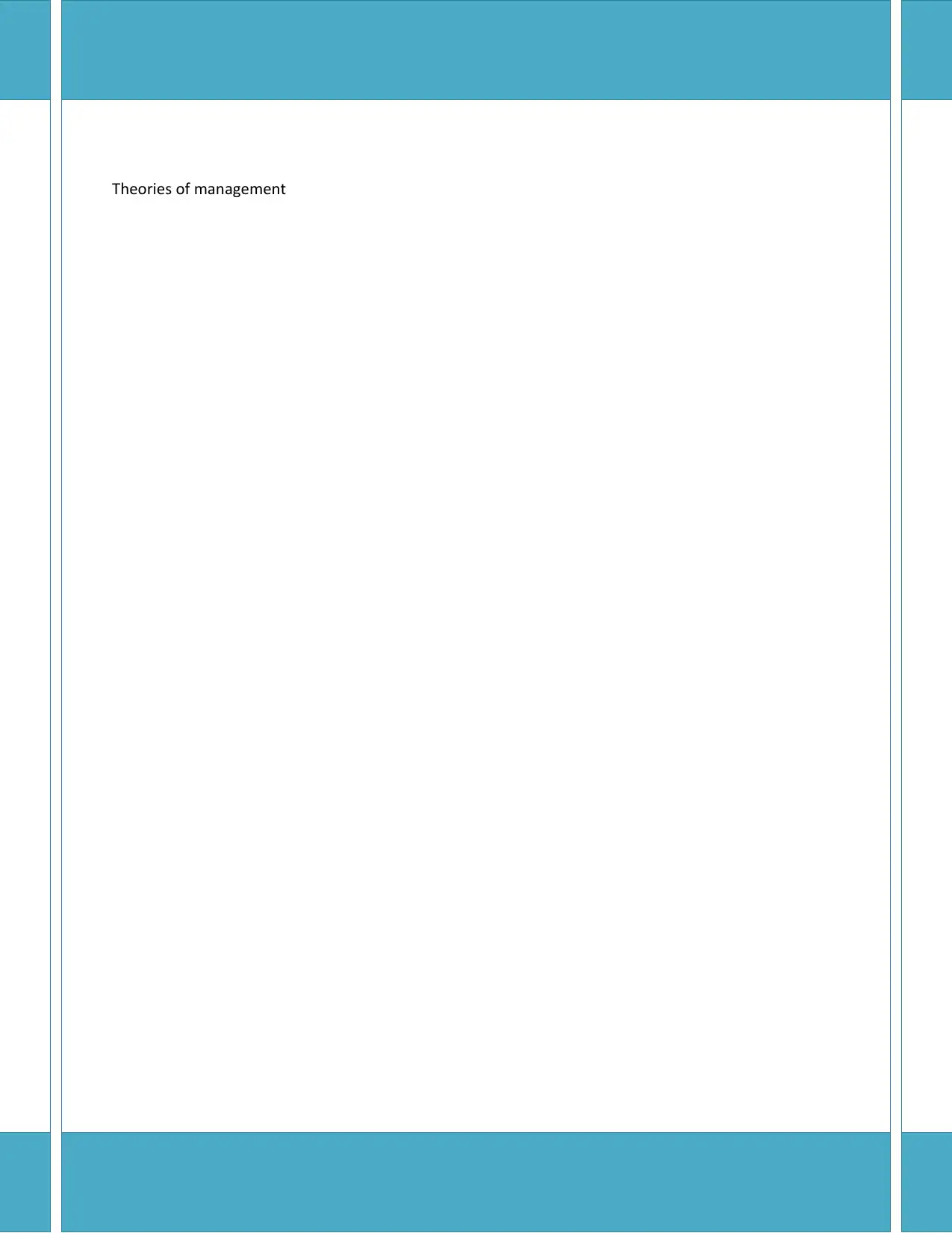
Theories of management
Paraphrase This Document
Need a fresh take? Get an instant paraphrase of this document with our AI Paraphraser
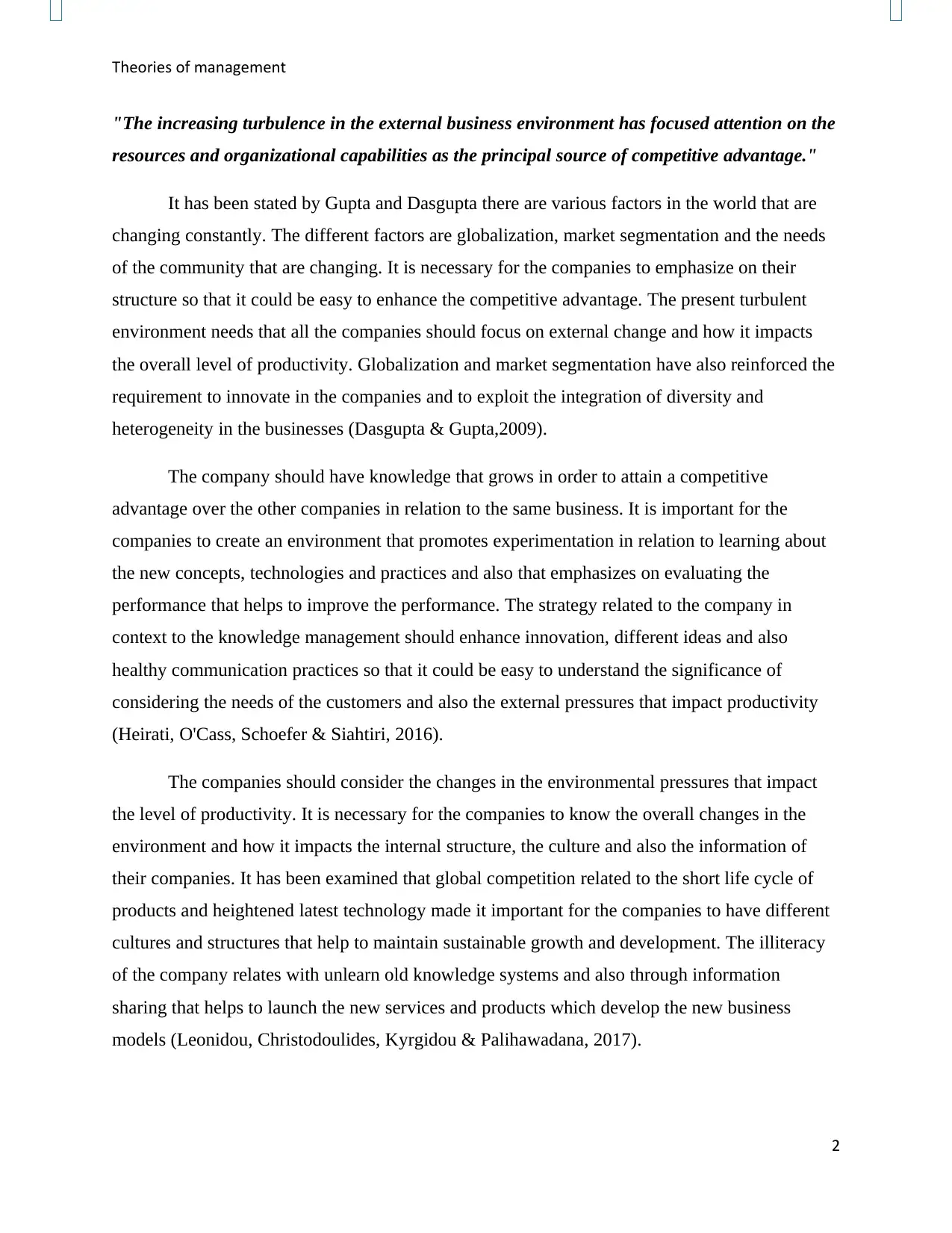
Theories of management
"The increasing turbulence in the external business environment has focused attention on the
resources and organizational capabilities as the principal source of competitive advantage."
It has been stated by Gupta and Dasgupta there are various factors in the world that are
changing constantly. The different factors are globalization, market segmentation and the needs
of the community that are changing. It is necessary for the companies to emphasize on their
structure so that it could be easy to enhance the competitive advantage. The present turbulent
environment needs that all the companies should focus on external change and how it impacts
the overall level of productivity. Globalization and market segmentation have also reinforced the
requirement to innovate in the companies and to exploit the integration of diversity and
heterogeneity in the businesses (Dasgupta & Gupta,2009).
The company should have knowledge that grows in order to attain a competitive
advantage over the other companies in relation to the same business. It is important for the
companies to create an environment that promotes experimentation in relation to learning about
the new concepts, technologies and practices and also that emphasizes on evaluating the
performance that helps to improve the performance. The strategy related to the company in
context to the knowledge management should enhance innovation, different ideas and also
healthy communication practices so that it could be easy to understand the significance of
considering the needs of the customers and also the external pressures that impact productivity
(Heirati, O'Cass, Schoefer & Siahtiri, 2016).
The companies should consider the changes in the environmental pressures that impact
the level of productivity. It is necessary for the companies to know the overall changes in the
environment and how it impacts the internal structure, the culture and also the information of
their companies. It has been examined that global competition related to the short life cycle of
products and heightened latest technology made it important for the companies to have different
cultures and structures that help to maintain sustainable growth and development. The illiteracy
of the company relates with unlearn old knowledge systems and also through information
sharing that helps to launch the new services and products which develop the new business
models (Leonidou, Christodoulides, Kyrgidou & Palihawadana, 2017).
2
"The increasing turbulence in the external business environment has focused attention on the
resources and organizational capabilities as the principal source of competitive advantage."
It has been stated by Gupta and Dasgupta there are various factors in the world that are
changing constantly. The different factors are globalization, market segmentation and the needs
of the community that are changing. It is necessary for the companies to emphasize on their
structure so that it could be easy to enhance the competitive advantage. The present turbulent
environment needs that all the companies should focus on external change and how it impacts
the overall level of productivity. Globalization and market segmentation have also reinforced the
requirement to innovate in the companies and to exploit the integration of diversity and
heterogeneity in the businesses (Dasgupta & Gupta,2009).
The company should have knowledge that grows in order to attain a competitive
advantage over the other companies in relation to the same business. It is important for the
companies to create an environment that promotes experimentation in relation to learning about
the new concepts, technologies and practices and also that emphasizes on evaluating the
performance that helps to improve the performance. The strategy related to the company in
context to the knowledge management should enhance innovation, different ideas and also
healthy communication practices so that it could be easy to understand the significance of
considering the needs of the customers and also the external pressures that impact productivity
(Heirati, O'Cass, Schoefer & Siahtiri, 2016).
The companies should consider the changes in the environmental pressures that impact
the level of productivity. It is necessary for the companies to know the overall changes in the
environment and how it impacts the internal structure, the culture and also the information of
their companies. It has been examined that global competition related to the short life cycle of
products and heightened latest technology made it important for the companies to have different
cultures and structures that help to maintain sustainable growth and development. The illiteracy
of the company relates with unlearn old knowledge systems and also through information
sharing that helps to launch the new services and products which develop the new business
models (Leonidou, Christodoulides, Kyrgidou & Palihawadana, 2017).
2

Theories of management
The company has the ability to change and also it determines to be more innovative by
considering the human resource as the knowledge assets that offer lucrative leverage to maintain
its competitiveness. To emphasize on the knowledge management it is important for the
managers to integrate innovative practice and knowledge so that the knowledge related with
innovation can be enhanced (Li, Wu, Holsapple & Goldsby, 2017).
The knowledge and human resource management are important for maintaining the
atmosphere of teaching in companies. It has been examined that implicit and explicit knowledge
is important to be controlled so that organizational learning can be enhanced. It will also help to
reinforce the experimentation within the company and this will also help to boost the process of
innovation which will help to leverage the overall organizational competitiveness. It is important
to maintain the environment so that knowledge management and human resource management
can be guided of the company and its innovativeness can also help in maintaining success and
failure which will create more lessons that the companies can consider to build innovation
(Leonidou, Christodoulides & Thwaites, 2016).
Gupta and Dasgupta in relation to knowledge creation stated that it focuses on the new
knowledge in the collaborative environment. It is said that knowledge is considered as the
market, process, and approaches that will be applied in relation to the knowledge of the
companies in meeting the strategic goals. Knowledge creation depends on internal and external
factors that can assist in maintaining the overall activities related to learning. The creation of the
knowledge needs an organizational capability to manage the activities in the turbulent
environment. The overall capabilities help in adaption and resilience to boost the overall
competitive advantage (Chuang & Lin, 2017).
It can be stated that the approach related to capabilities focuses on understanding how the
competitive advantage can be maintained in the changing environment. It is important for the
company to take into considering the resources and capabilities that will help to consider the
changing environment just because of difficulties and also instability that is related to the
external environment. The external environment can affect the growth and potential of the
company. So, the knowledge creation focuses on the internal environment that helps to enhance
the organizational resilience which manages the overall changes that are outside of the company.
This can be also stated as the initial step that creates the dynamic capabilities and resilience for
3
The company has the ability to change and also it determines to be more innovative by
considering the human resource as the knowledge assets that offer lucrative leverage to maintain
its competitiveness. To emphasize on the knowledge management it is important for the
managers to integrate innovative practice and knowledge so that the knowledge related with
innovation can be enhanced (Li, Wu, Holsapple & Goldsby, 2017).
The knowledge and human resource management are important for maintaining the
atmosphere of teaching in companies. It has been examined that implicit and explicit knowledge
is important to be controlled so that organizational learning can be enhanced. It will also help to
reinforce the experimentation within the company and this will also help to boost the process of
innovation which will help to leverage the overall organizational competitiveness. It is important
to maintain the environment so that knowledge management and human resource management
can be guided of the company and its innovativeness can also help in maintaining success and
failure which will create more lessons that the companies can consider to build innovation
(Leonidou, Christodoulides & Thwaites, 2016).
Gupta and Dasgupta in relation to knowledge creation stated that it focuses on the new
knowledge in the collaborative environment. It is said that knowledge is considered as the
market, process, and approaches that will be applied in relation to the knowledge of the
companies in meeting the strategic goals. Knowledge creation depends on internal and external
factors that can assist in maintaining the overall activities related to learning. The creation of the
knowledge needs an organizational capability to manage the activities in the turbulent
environment. The overall capabilities help in adaption and resilience to boost the overall
competitive advantage (Chuang & Lin, 2017).
It can be stated that the approach related to capabilities focuses on understanding how the
competitive advantage can be maintained in the changing environment. It is important for the
company to take into considering the resources and capabilities that will help to consider the
changing environment just because of difficulties and also instability that is related to the
external environment. The external environment can affect the growth and potential of the
company. So, the knowledge creation focuses on the internal environment that helps to enhance
the organizational resilience which manages the overall changes that are outside of the company.
This can be also stated as the initial step that creates the dynamic capabilities and resilience for
3
⊘ This is a preview!⊘
Do you want full access?
Subscribe today to unlock all pages.

Trusted by 1+ million students worldwide
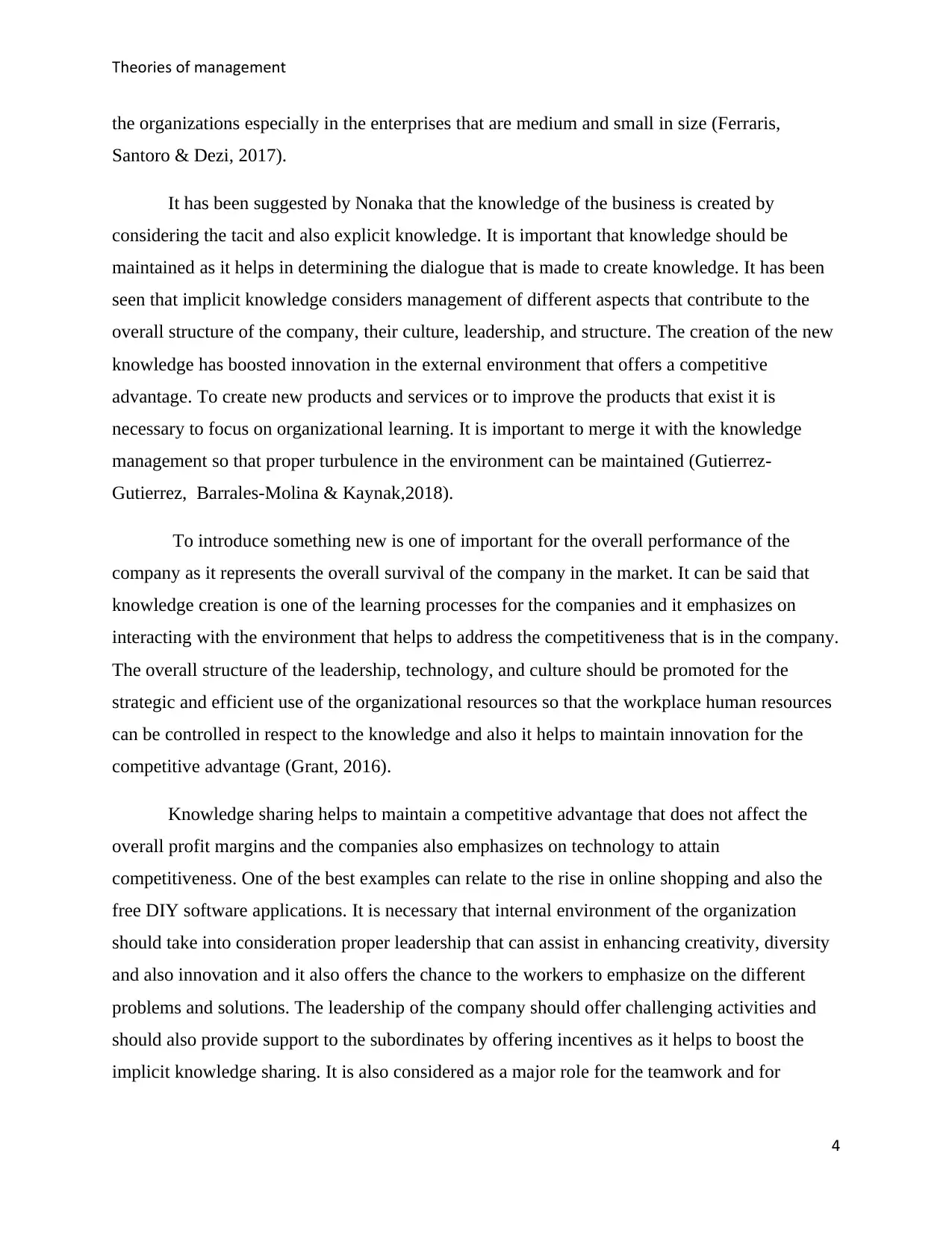
Theories of management
the organizations especially in the enterprises that are medium and small in size (Ferraris,
Santoro & Dezi, 2017).
It has been suggested by Nonaka that the knowledge of the business is created by
considering the tacit and also explicit knowledge. It is important that knowledge should be
maintained as it helps in determining the dialogue that is made to create knowledge. It has been
seen that implicit knowledge considers management of different aspects that contribute to the
overall structure of the company, their culture, leadership, and structure. The creation of the new
knowledge has boosted innovation in the external environment that offers a competitive
advantage. To create new products and services or to improve the products that exist it is
necessary to focus on organizational learning. It is important to merge it with the knowledge
management so that proper turbulence in the environment can be maintained (Gutierrez-
Gutierrez, Barrales-Molina & Kaynak,2018).
To introduce something new is one of important for the overall performance of the
company as it represents the overall survival of the company in the market. It can be said that
knowledge creation is one of the learning processes for the companies and it emphasizes on
interacting with the environment that helps to address the competitiveness that is in the company.
The overall structure of the leadership, technology, and culture should be promoted for the
strategic and efficient use of the organizational resources so that the workplace human resources
can be controlled in respect to the knowledge and also it helps to maintain innovation for the
competitive advantage (Grant, 2016).
Knowledge sharing helps to maintain a competitive advantage that does not affect the
overall profit margins and the companies also emphasizes on technology to attain
competitiveness. One of the best examples can relate to the rise in online shopping and also the
free DIY software applications. It is necessary that internal environment of the organization
should take into consideration proper leadership that can assist in enhancing creativity, diversity
and also innovation and it also offers the chance to the workers to emphasize on the different
problems and solutions. The leadership of the company should offer challenging activities and
should also provide support to the subordinates by offering incentives as it helps to boost the
implicit knowledge sharing. It is also considered as a major role for the teamwork and for
4
the organizations especially in the enterprises that are medium and small in size (Ferraris,
Santoro & Dezi, 2017).
It has been suggested by Nonaka that the knowledge of the business is created by
considering the tacit and also explicit knowledge. It is important that knowledge should be
maintained as it helps in determining the dialogue that is made to create knowledge. It has been
seen that implicit knowledge considers management of different aspects that contribute to the
overall structure of the company, their culture, leadership, and structure. The creation of the new
knowledge has boosted innovation in the external environment that offers a competitive
advantage. To create new products and services or to improve the products that exist it is
necessary to focus on organizational learning. It is important to merge it with the knowledge
management so that proper turbulence in the environment can be maintained (Gutierrez-
Gutierrez, Barrales-Molina & Kaynak,2018).
To introduce something new is one of important for the overall performance of the
company as it represents the overall survival of the company in the market. It can be said that
knowledge creation is one of the learning processes for the companies and it emphasizes on
interacting with the environment that helps to address the competitiveness that is in the company.
The overall structure of the leadership, technology, and culture should be promoted for the
strategic and efficient use of the organizational resources so that the workplace human resources
can be controlled in respect to the knowledge and also it helps to maintain innovation for the
competitive advantage (Grant, 2016).
Knowledge sharing helps to maintain a competitive advantage that does not affect the
overall profit margins and the companies also emphasizes on technology to attain
competitiveness. One of the best examples can relate to the rise in online shopping and also the
free DIY software applications. It is necessary that internal environment of the organization
should take into consideration proper leadership that can assist in enhancing creativity, diversity
and also innovation and it also offers the chance to the workers to emphasize on the different
problems and solutions. The leadership of the company should offer challenging activities and
should also provide support to the subordinates by offering incentives as it helps to boost the
implicit knowledge sharing. It is also considered as a major role for the teamwork and for
4
Paraphrase This Document
Need a fresh take? Get an instant paraphrase of this document with our AI Paraphraser
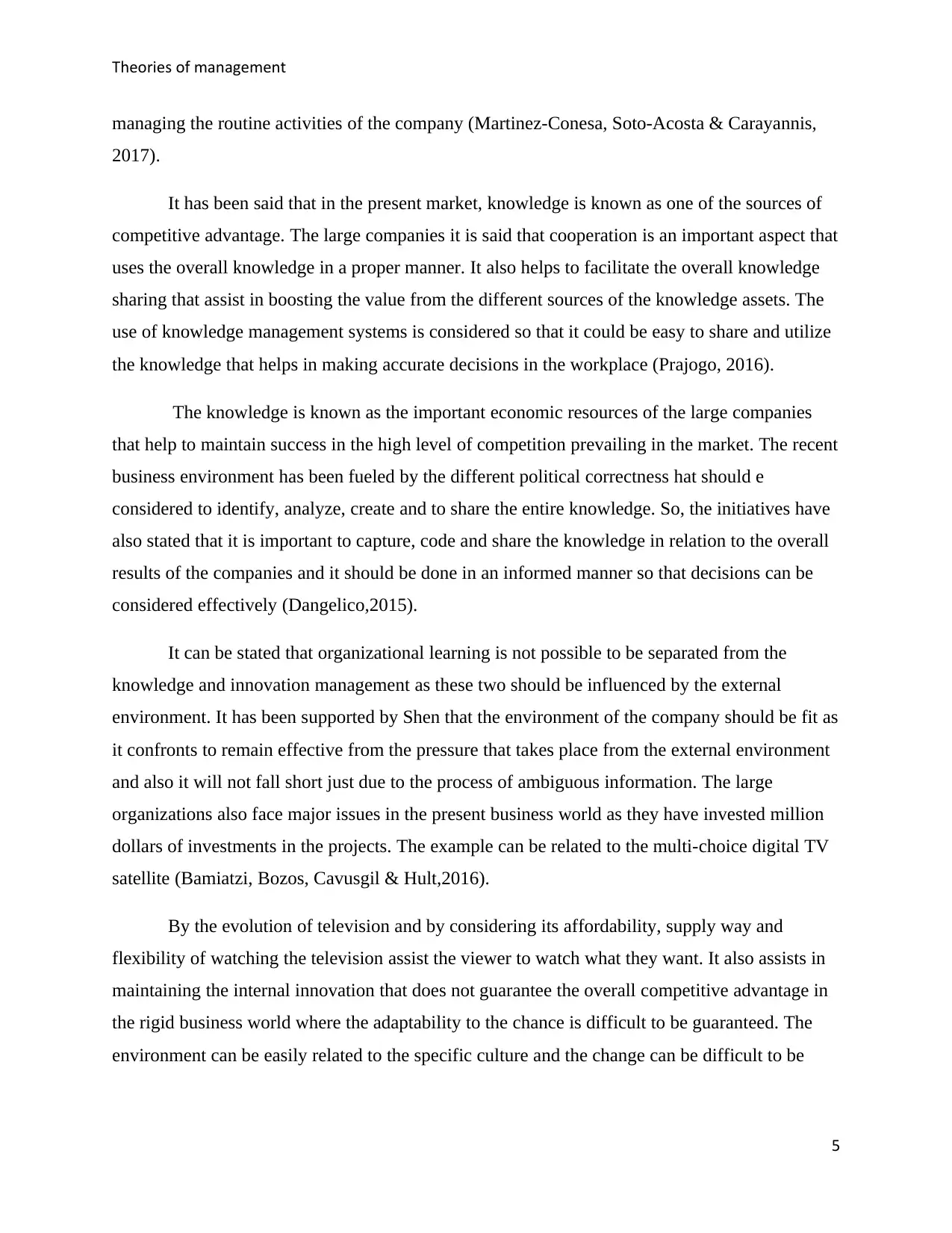
Theories of management
managing the routine activities of the company (Martinez-Conesa, Soto-Acosta & Carayannis,
2017).
It has been said that in the present market, knowledge is known as one of the sources of
competitive advantage. The large companies it is said that cooperation is an important aspect that
uses the overall knowledge in a proper manner. It also helps to facilitate the overall knowledge
sharing that assist in boosting the value from the different sources of the knowledge assets. The
use of knowledge management systems is considered so that it could be easy to share and utilize
the knowledge that helps in making accurate decisions in the workplace (Prajogo, 2016).
The knowledge is known as the important economic resources of the large companies
that help to maintain success in the high level of competition prevailing in the market. The recent
business environment has been fueled by the different political correctness hat should e
considered to identify, analyze, create and to share the entire knowledge. So, the initiatives have
also stated that it is important to capture, code and share the knowledge in relation to the overall
results of the companies and it should be done in an informed manner so that decisions can be
considered effectively (Dangelico,2015).
It can be stated that organizational learning is not possible to be separated from the
knowledge and innovation management as these two should be influenced by the external
environment. It has been supported by Shen that the environment of the company should be fit as
it confronts to remain effective from the pressure that takes place from the external environment
and also it will not fall short just due to the process of ambiguous information. The large
organizations also face major issues in the present business world as they have invested million
dollars of investments in the projects. The example can be related to the multi-choice digital TV
satellite (Bamiatzi, Bozos, Cavusgil & Hult,2016).
By the evolution of television and by considering its affordability, supply way and
flexibility of watching the television assist the viewer to watch what they want. It also assists in
maintaining the internal innovation that does not guarantee the overall competitive advantage in
the rigid business world where the adaptability to the chance is difficult to be guaranteed. The
environment can be easily related to the specific culture and the change can be difficult to be
5
managing the routine activities of the company (Martinez-Conesa, Soto-Acosta & Carayannis,
2017).
It has been said that in the present market, knowledge is known as one of the sources of
competitive advantage. The large companies it is said that cooperation is an important aspect that
uses the overall knowledge in a proper manner. It also helps to facilitate the overall knowledge
sharing that assist in boosting the value from the different sources of the knowledge assets. The
use of knowledge management systems is considered so that it could be easy to share and utilize
the knowledge that helps in making accurate decisions in the workplace (Prajogo, 2016).
The knowledge is known as the important economic resources of the large companies
that help to maintain success in the high level of competition prevailing in the market. The recent
business environment has been fueled by the different political correctness hat should e
considered to identify, analyze, create and to share the entire knowledge. So, the initiatives have
also stated that it is important to capture, code and share the knowledge in relation to the overall
results of the companies and it should be done in an informed manner so that decisions can be
considered effectively (Dangelico,2015).
It can be stated that organizational learning is not possible to be separated from the
knowledge and innovation management as these two should be influenced by the external
environment. It has been supported by Shen that the environment of the company should be fit as
it confronts to remain effective from the pressure that takes place from the external environment
and also it will not fall short just due to the process of ambiguous information. The large
organizations also face major issues in the present business world as they have invested million
dollars of investments in the projects. The example can be related to the multi-choice digital TV
satellite (Bamiatzi, Bozos, Cavusgil & Hult,2016).
By the evolution of television and by considering its affordability, supply way and
flexibility of watching the television assist the viewer to watch what they want. It also assists in
maintaining the internal innovation that does not guarantee the overall competitive advantage in
the rigid business world where the adaptability to the chance is difficult to be guaranteed. The
environment can be easily related to the specific culture and the change can be difficult to be
5
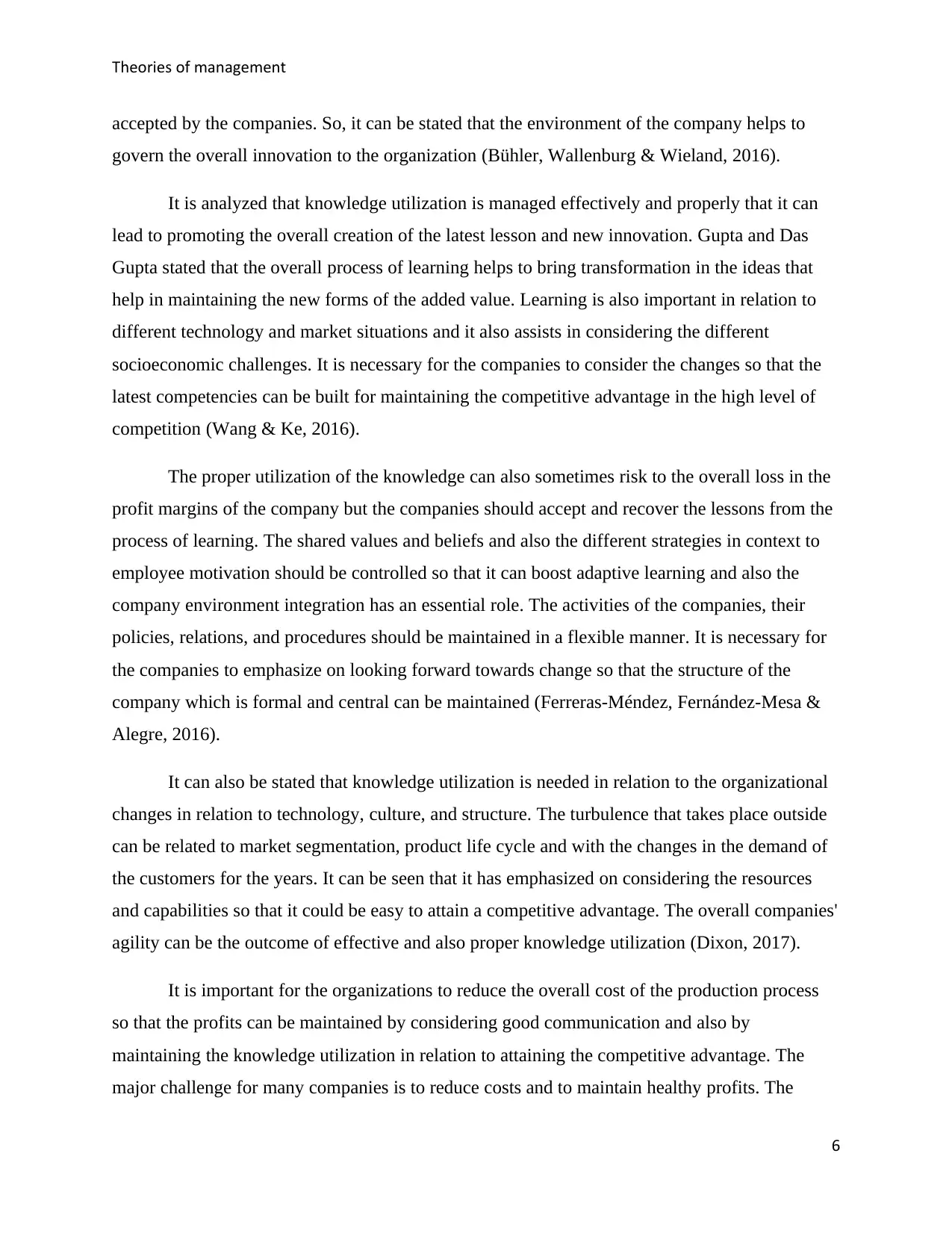
Theories of management
accepted by the companies. So, it can be stated that the environment of the company helps to
govern the overall innovation to the organization (Bühler, Wallenburg & Wieland, 2016).
It is analyzed that knowledge utilization is managed effectively and properly that it can
lead to promoting the overall creation of the latest lesson and new innovation. Gupta and Das
Gupta stated that the overall process of learning helps to bring transformation in the ideas that
help in maintaining the new forms of the added value. Learning is also important in relation to
different technology and market situations and it also assists in considering the different
socioeconomic challenges. It is necessary for the companies to consider the changes so that the
latest competencies can be built for maintaining the competitive advantage in the high level of
competition (Wang & Ke, 2016).
The proper utilization of the knowledge can also sometimes risk to the overall loss in the
profit margins of the company but the companies should accept and recover the lessons from the
process of learning. The shared values and beliefs and also the different strategies in context to
employee motivation should be controlled so that it can boost adaptive learning and also the
company environment integration has an essential role. The activities of the companies, their
policies, relations, and procedures should be maintained in a flexible manner. It is necessary for
the companies to emphasize on looking forward towards change so that the structure of the
company which is formal and central can be maintained (Ferreras-Méndez, Fernández-Mesa &
Alegre, 2016).
It can also be stated that knowledge utilization is needed in relation to the organizational
changes in relation to technology, culture, and structure. The turbulence that takes place outside
can be related to market segmentation, product life cycle and with the changes in the demand of
the customers for the years. It can be seen that it has emphasized on considering the resources
and capabilities so that it could be easy to attain a competitive advantage. The overall companies'
agility can be the outcome of effective and also proper knowledge utilization (Dixon, 2017).
It is important for the organizations to reduce the overall cost of the production process
so that the profits can be maintained by considering good communication and also by
maintaining the knowledge utilization in relation to attaining the competitive advantage. The
major challenge for many companies is to reduce costs and to maintain healthy profits. The
6
accepted by the companies. So, it can be stated that the environment of the company helps to
govern the overall innovation to the organization (Bühler, Wallenburg & Wieland, 2016).
It is analyzed that knowledge utilization is managed effectively and properly that it can
lead to promoting the overall creation of the latest lesson and new innovation. Gupta and Das
Gupta stated that the overall process of learning helps to bring transformation in the ideas that
help in maintaining the new forms of the added value. Learning is also important in relation to
different technology and market situations and it also assists in considering the different
socioeconomic challenges. It is necessary for the companies to consider the changes so that the
latest competencies can be built for maintaining the competitive advantage in the high level of
competition (Wang & Ke, 2016).
The proper utilization of the knowledge can also sometimes risk to the overall loss in the
profit margins of the company but the companies should accept and recover the lessons from the
process of learning. The shared values and beliefs and also the different strategies in context to
employee motivation should be controlled so that it can boost adaptive learning and also the
company environment integration has an essential role. The activities of the companies, their
policies, relations, and procedures should be maintained in a flexible manner. It is necessary for
the companies to emphasize on looking forward towards change so that the structure of the
company which is formal and central can be maintained (Ferreras-Méndez, Fernández-Mesa &
Alegre, 2016).
It can also be stated that knowledge utilization is needed in relation to the organizational
changes in relation to technology, culture, and structure. The turbulence that takes place outside
can be related to market segmentation, product life cycle and with the changes in the demand of
the customers for the years. It can be seen that it has emphasized on considering the resources
and capabilities so that it could be easy to attain a competitive advantage. The overall companies'
agility can be the outcome of effective and also proper knowledge utilization (Dixon, 2017).
It is important for the organizations to reduce the overall cost of the production process
so that the profits can be maintained by considering good communication and also by
maintaining the knowledge utilization in relation to attaining the competitive advantage. The
major challenge for many companies is to reduce costs and to maintain healthy profits. The
6
⊘ This is a preview!⊘
Do you want full access?
Subscribe today to unlock all pages.

Trusted by 1+ million students worldwide

Theories of management
external aspects related to turbulence environment relates to the knowledge that is attained and
shared. It can also be said at last that knowledge utilization can be created through organizational
change and innovation (Camps, Oltra, Aldás‐Manzano, Buenaventura‐Vera & Torres‐Carballo,
2016).
The different culture and also the changing environment of the organizations in the
present era can be determined for the different resources and capabilities that help to attain a
competitive advantage. It is also concerned with the survival and profit margin ratio of the
companies that satisfy the needs of the people and also tries to bring improvisation in the lives of
the individuals. The example that can be related to this is of Econet Zimbabwe which is the
biggest telecommunication service provider and it has been existed only due to the advanced
technological advancement and the social responsibility that meet the needs in the environment.
Also, one of the examples is related with the introduction of the rented point f sale machines in
the country where the issue related with the cash and also the more dependency is on the plastic
money (Ansoff, Kipley, Lewis, Helm-Stevens & Ansoff, 2019).
It is seen that the overall agility of the company is important as it assists in maintaining
the fundamental market place shifts. It can also be said that technology is one of the important
aspects that helps to maintain flexibility and technology is also used as the agent of change that
helps to maintain the data. There are also internal barriers that change the efforts of the
companies in relation to the common challenges that should be improved s it will assist in
solving the problems related with slow decision making and also risk-averse cultures
(Spyropoulou, Katsikeas, Skarmeas & Morgan, 2018).
The needs of the customers cannot be the longer statics in relation to the companies that
do not focuses more on profits. In the present globalized market scenario, it has been examined
that the ability to satisfy the expectations of the customers is related with enhancing the profits
but the needs of the customers are also changing on the fast pace. There are also different traits
that are important for the overall growth of the company and it also leads to innovation and
enhances the overall experience of the customers. The word Agility simply relates with searching
for the new and funding sources in relation to the different functions and it also depends on the
organization structure, culture and can vary in respect to the fluctuation that takes place in the
market (Wilden & Gudergan, 2015).
7
external aspects related to turbulence environment relates to the knowledge that is attained and
shared. It can also be said at last that knowledge utilization can be created through organizational
change and innovation (Camps, Oltra, Aldás‐Manzano, Buenaventura‐Vera & Torres‐Carballo,
2016).
The different culture and also the changing environment of the organizations in the
present era can be determined for the different resources and capabilities that help to attain a
competitive advantage. It is also concerned with the survival and profit margin ratio of the
companies that satisfy the needs of the people and also tries to bring improvisation in the lives of
the individuals. The example that can be related to this is of Econet Zimbabwe which is the
biggest telecommunication service provider and it has been existed only due to the advanced
technological advancement and the social responsibility that meet the needs in the environment.
Also, one of the examples is related with the introduction of the rented point f sale machines in
the country where the issue related with the cash and also the more dependency is on the plastic
money (Ansoff, Kipley, Lewis, Helm-Stevens & Ansoff, 2019).
It is seen that the overall agility of the company is important as it assists in maintaining
the fundamental market place shifts. It can also be said that technology is one of the important
aspects that helps to maintain flexibility and technology is also used as the agent of change that
helps to maintain the data. There are also internal barriers that change the efforts of the
companies in relation to the common challenges that should be improved s it will assist in
solving the problems related with slow decision making and also risk-averse cultures
(Spyropoulou, Katsikeas, Skarmeas & Morgan, 2018).
The needs of the customers cannot be the longer statics in relation to the companies that
do not focuses more on profits. In the present globalized market scenario, it has been examined
that the ability to satisfy the expectations of the customers is related with enhancing the profits
but the needs of the customers are also changing on the fast pace. There are also different traits
that are important for the overall growth of the company and it also leads to innovation and
enhances the overall experience of the customers. The word Agility simply relates with searching
for the new and funding sources in relation to the different functions and it also depends on the
organization structure, culture and can vary in respect to the fluctuation that takes place in the
market (Wilden & Gudergan, 2015).
7
Paraphrase This Document
Need a fresh take? Get an instant paraphrase of this document with our AI Paraphraser
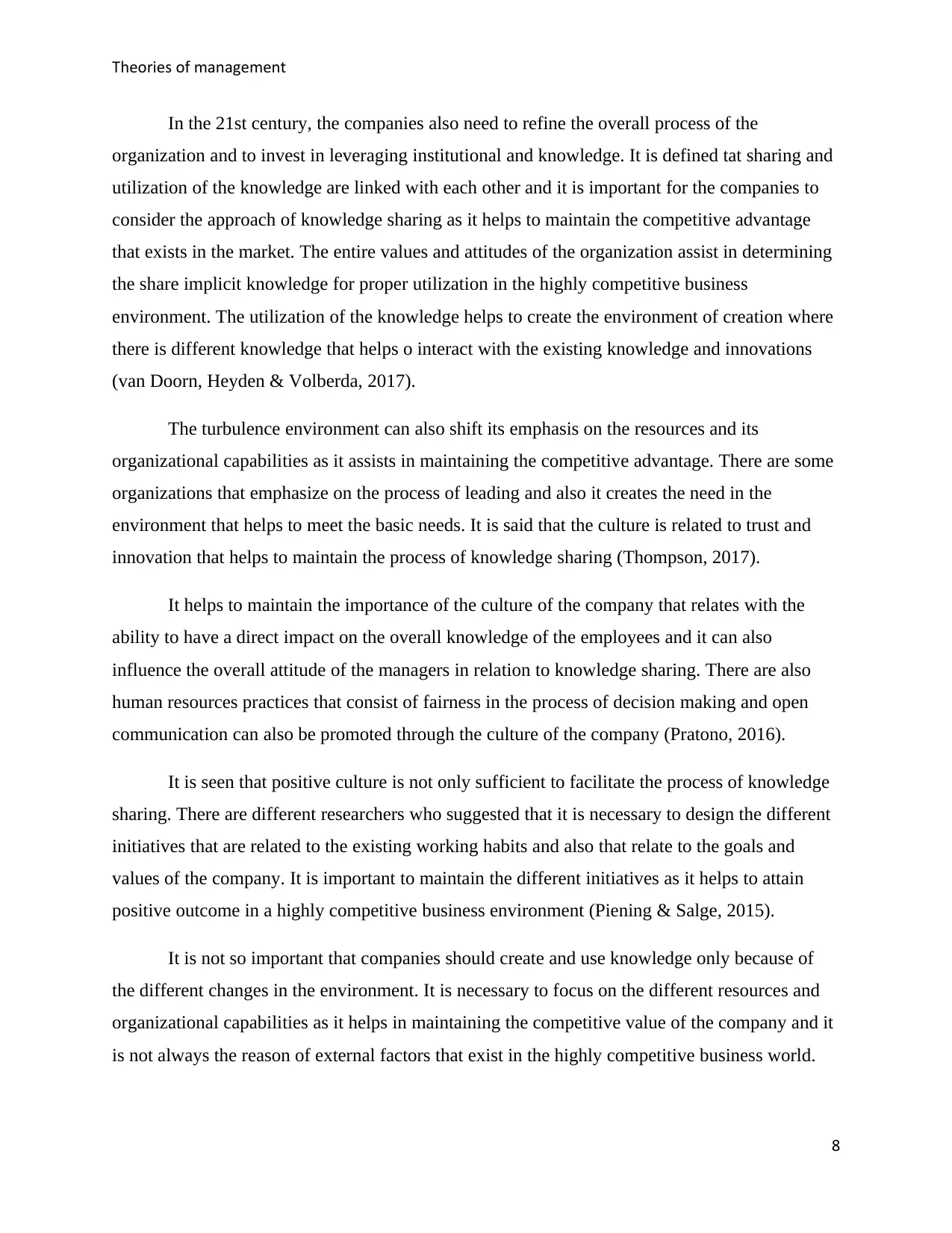
Theories of management
In the 21st century, the companies also need to refine the overall process of the
organization and to invest in leveraging institutional and knowledge. It is defined tat sharing and
utilization of the knowledge are linked with each other and it is important for the companies to
consider the approach of knowledge sharing as it helps to maintain the competitive advantage
that exists in the market. The entire values and attitudes of the organization assist in determining
the share implicit knowledge for proper utilization in the highly competitive business
environment. The utilization of the knowledge helps to create the environment of creation where
there is different knowledge that helps o interact with the existing knowledge and innovations
(van Doorn, Heyden & Volberda, 2017).
The turbulence environment can also shift its emphasis on the resources and its
organizational capabilities as it assists in maintaining the competitive advantage. There are some
organizations that emphasize on the process of leading and also it creates the need in the
environment that helps to meet the basic needs. It is said that the culture is related to trust and
innovation that helps to maintain the process of knowledge sharing (Thompson, 2017).
It helps to maintain the importance of the culture of the company that relates with the
ability to have a direct impact on the overall knowledge of the employees and it can also
influence the overall attitude of the managers in relation to knowledge sharing. There are also
human resources practices that consist of fairness in the process of decision making and open
communication can also be promoted through the culture of the company (Pratono, 2016).
It is seen that positive culture is not only sufficient to facilitate the process of knowledge
sharing. There are different researchers who suggested that it is necessary to design the different
initiatives that are related to the existing working habits and also that relate to the goals and
values of the company. It is important to maintain the different initiatives as it helps to attain
positive outcome in a highly competitive business environment (Piening & Salge, 2015).
It is not so important that companies should create and use knowledge only because of
the different changes in the environment. It is necessary to focus on the different resources and
organizational capabilities as it helps in maintaining the competitive value of the company and it
is not always the reason of external factors that exist in the highly competitive business world.
8
In the 21st century, the companies also need to refine the overall process of the
organization and to invest in leveraging institutional and knowledge. It is defined tat sharing and
utilization of the knowledge are linked with each other and it is important for the companies to
consider the approach of knowledge sharing as it helps to maintain the competitive advantage
that exists in the market. The entire values and attitudes of the organization assist in determining
the share implicit knowledge for proper utilization in the highly competitive business
environment. The utilization of the knowledge helps to create the environment of creation where
there is different knowledge that helps o interact with the existing knowledge and innovations
(van Doorn, Heyden & Volberda, 2017).
The turbulence environment can also shift its emphasis on the resources and its
organizational capabilities as it assists in maintaining the competitive advantage. There are some
organizations that emphasize on the process of leading and also it creates the need in the
environment that helps to meet the basic needs. It is said that the culture is related to trust and
innovation that helps to maintain the process of knowledge sharing (Thompson, 2017).
It helps to maintain the importance of the culture of the company that relates with the
ability to have a direct impact on the overall knowledge of the employees and it can also
influence the overall attitude of the managers in relation to knowledge sharing. There are also
human resources practices that consist of fairness in the process of decision making and open
communication can also be promoted through the culture of the company (Pratono, 2016).
It is seen that positive culture is not only sufficient to facilitate the process of knowledge
sharing. There are different researchers who suggested that it is necessary to design the different
initiatives that are related to the existing working habits and also that relate to the goals and
values of the company. It is important to maintain the different initiatives as it helps to attain
positive outcome in a highly competitive business environment (Piening & Salge, 2015).
It is not so important that companies should create and use knowledge only because of
the different changes in the environment. It is necessary to focus on the different resources and
organizational capabilities as it helps in maintaining the competitive value of the company and it
is not always the reason of external factors that exist in the highly competitive business world.
8
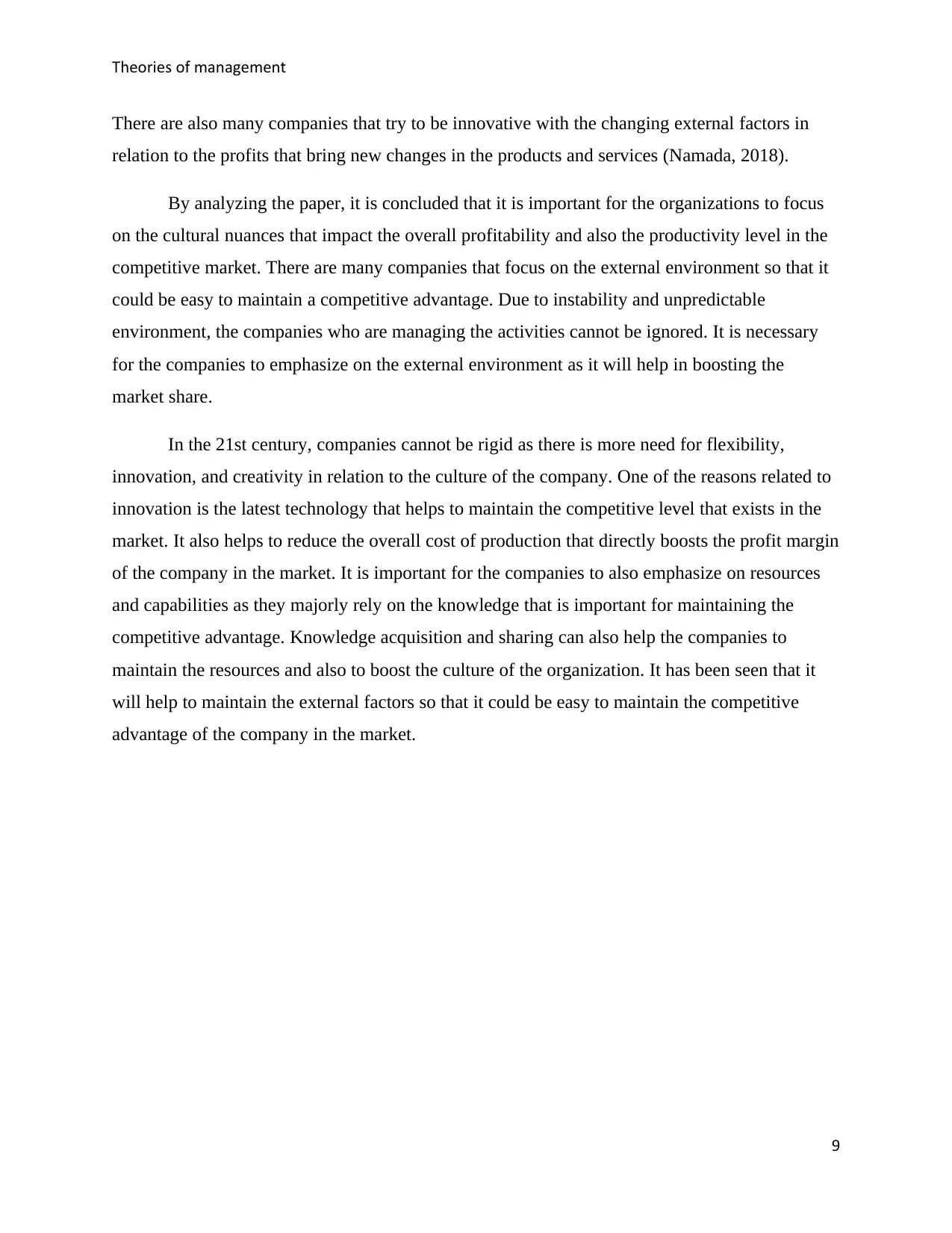
Theories of management
There are also many companies that try to be innovative with the changing external factors in
relation to the profits that bring new changes in the products and services (Namada, 2018).
By analyzing the paper, it is concluded that it is important for the organizations to focus
on the cultural nuances that impact the overall profitability and also the productivity level in the
competitive market. There are many companies that focus on the external environment so that it
could be easy to maintain a competitive advantage. Due to instability and unpredictable
environment, the companies who are managing the activities cannot be ignored. It is necessary
for the companies to emphasize on the external environment as it will help in boosting the
market share.
In the 21st century, companies cannot be rigid as there is more need for flexibility,
innovation, and creativity in relation to the culture of the company. One of the reasons related to
innovation is the latest technology that helps to maintain the competitive level that exists in the
market. It also helps to reduce the overall cost of production that directly boosts the profit margin
of the company in the market. It is important for the companies to also emphasize on resources
and capabilities as they majorly rely on the knowledge that is important for maintaining the
competitive advantage. Knowledge acquisition and sharing can also help the companies to
maintain the resources and also to boost the culture of the organization. It has been seen that it
will help to maintain the external factors so that it could be easy to maintain the competitive
advantage of the company in the market.
9
There are also many companies that try to be innovative with the changing external factors in
relation to the profits that bring new changes in the products and services (Namada, 2018).
By analyzing the paper, it is concluded that it is important for the organizations to focus
on the cultural nuances that impact the overall profitability and also the productivity level in the
competitive market. There are many companies that focus on the external environment so that it
could be easy to maintain a competitive advantage. Due to instability and unpredictable
environment, the companies who are managing the activities cannot be ignored. It is necessary
for the companies to emphasize on the external environment as it will help in boosting the
market share.
In the 21st century, companies cannot be rigid as there is more need for flexibility,
innovation, and creativity in relation to the culture of the company. One of the reasons related to
innovation is the latest technology that helps to maintain the competitive level that exists in the
market. It also helps to reduce the overall cost of production that directly boosts the profit margin
of the company in the market. It is important for the companies to also emphasize on resources
and capabilities as they majorly rely on the knowledge that is important for maintaining the
competitive advantage. Knowledge acquisition and sharing can also help the companies to
maintain the resources and also to boost the culture of the organization. It has been seen that it
will help to maintain the external factors so that it could be easy to maintain the competitive
advantage of the company in the market.
9
⊘ This is a preview!⊘
Do you want full access?
Subscribe today to unlock all pages.

Trusted by 1+ million students worldwide
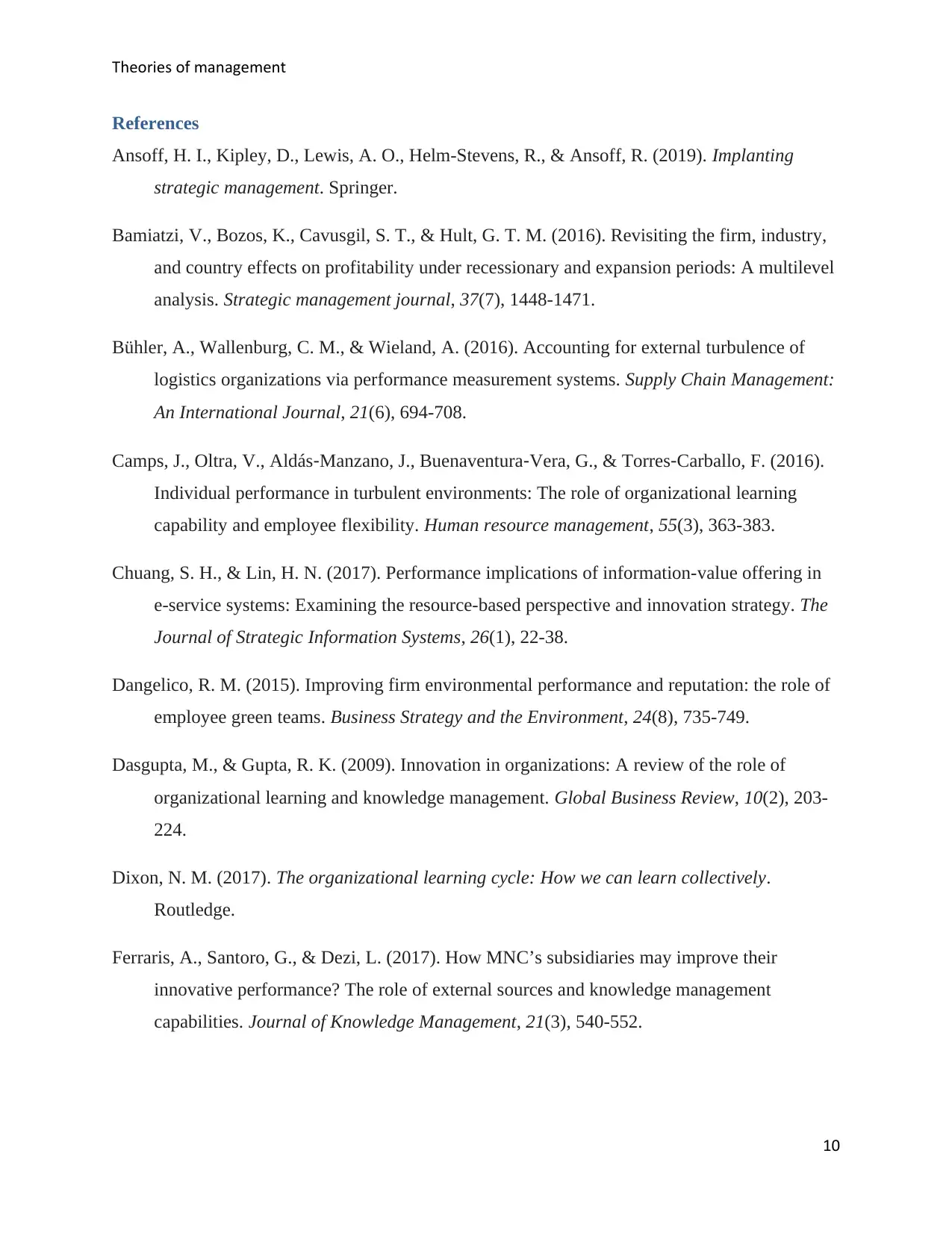
Theories of management
References
Ansoff, H. I., Kipley, D., Lewis, A. O., Helm-Stevens, R., & Ansoff, R. (2019). Implanting
strategic management. Springer.
Bamiatzi, V., Bozos, K., Cavusgil, S. T., & Hult, G. T. M. (2016). Revisiting the firm, industry,
and country effects on profitability under recessionary and expansion periods: A multilevel
analysis. Strategic management journal, 37(7), 1448-1471.
Bühler, A., Wallenburg, C. M., & Wieland, A. (2016). Accounting for external turbulence of
logistics organizations via performance measurement systems. Supply Chain Management:
An International Journal, 21(6), 694-708.
Camps, J., Oltra, V., Aldás‐Manzano, J., Buenaventura‐Vera, G., & Torres‐Carballo, F. (2016).
Individual performance in turbulent environments: The role of organizational learning
capability and employee flexibility. Human resource management, 55(3), 363-383.
Chuang, S. H., & Lin, H. N. (2017). Performance implications of information-value offering in
e-service systems: Examining the resource-based perspective and innovation strategy. The
Journal of Strategic Information Systems, 26(1), 22-38.
Dangelico, R. M. (2015). Improving firm environmental performance and reputation: the role of
employee green teams. Business Strategy and the Environment, 24(8), 735-749.
Dasgupta, M., & Gupta, R. K. (2009). Innovation in organizations: A review of the role of
organizational learning and knowledge management. Global Business Review, 10(2), 203-
224.
Dixon, N. M. (2017). The organizational learning cycle: How we can learn collectively.
Routledge.
Ferraris, A., Santoro, G., & Dezi, L. (2017). How MNC’s subsidiaries may improve their
innovative performance? The role of external sources and knowledge management
capabilities. Journal of Knowledge Management, 21(3), 540-552.
10
References
Ansoff, H. I., Kipley, D., Lewis, A. O., Helm-Stevens, R., & Ansoff, R. (2019). Implanting
strategic management. Springer.
Bamiatzi, V., Bozos, K., Cavusgil, S. T., & Hult, G. T. M. (2016). Revisiting the firm, industry,
and country effects on profitability under recessionary and expansion periods: A multilevel
analysis. Strategic management journal, 37(7), 1448-1471.
Bühler, A., Wallenburg, C. M., & Wieland, A. (2016). Accounting for external turbulence of
logistics organizations via performance measurement systems. Supply Chain Management:
An International Journal, 21(6), 694-708.
Camps, J., Oltra, V., Aldás‐Manzano, J., Buenaventura‐Vera, G., & Torres‐Carballo, F. (2016).
Individual performance in turbulent environments: The role of organizational learning
capability and employee flexibility. Human resource management, 55(3), 363-383.
Chuang, S. H., & Lin, H. N. (2017). Performance implications of information-value offering in
e-service systems: Examining the resource-based perspective and innovation strategy. The
Journal of Strategic Information Systems, 26(1), 22-38.
Dangelico, R. M. (2015). Improving firm environmental performance and reputation: the role of
employee green teams. Business Strategy and the Environment, 24(8), 735-749.
Dasgupta, M., & Gupta, R. K. (2009). Innovation in organizations: A review of the role of
organizational learning and knowledge management. Global Business Review, 10(2), 203-
224.
Dixon, N. M. (2017). The organizational learning cycle: How we can learn collectively.
Routledge.
Ferraris, A., Santoro, G., & Dezi, L. (2017). How MNC’s subsidiaries may improve their
innovative performance? The role of external sources and knowledge management
capabilities. Journal of Knowledge Management, 21(3), 540-552.
10
Paraphrase This Document
Need a fresh take? Get an instant paraphrase of this document with our AI Paraphraser
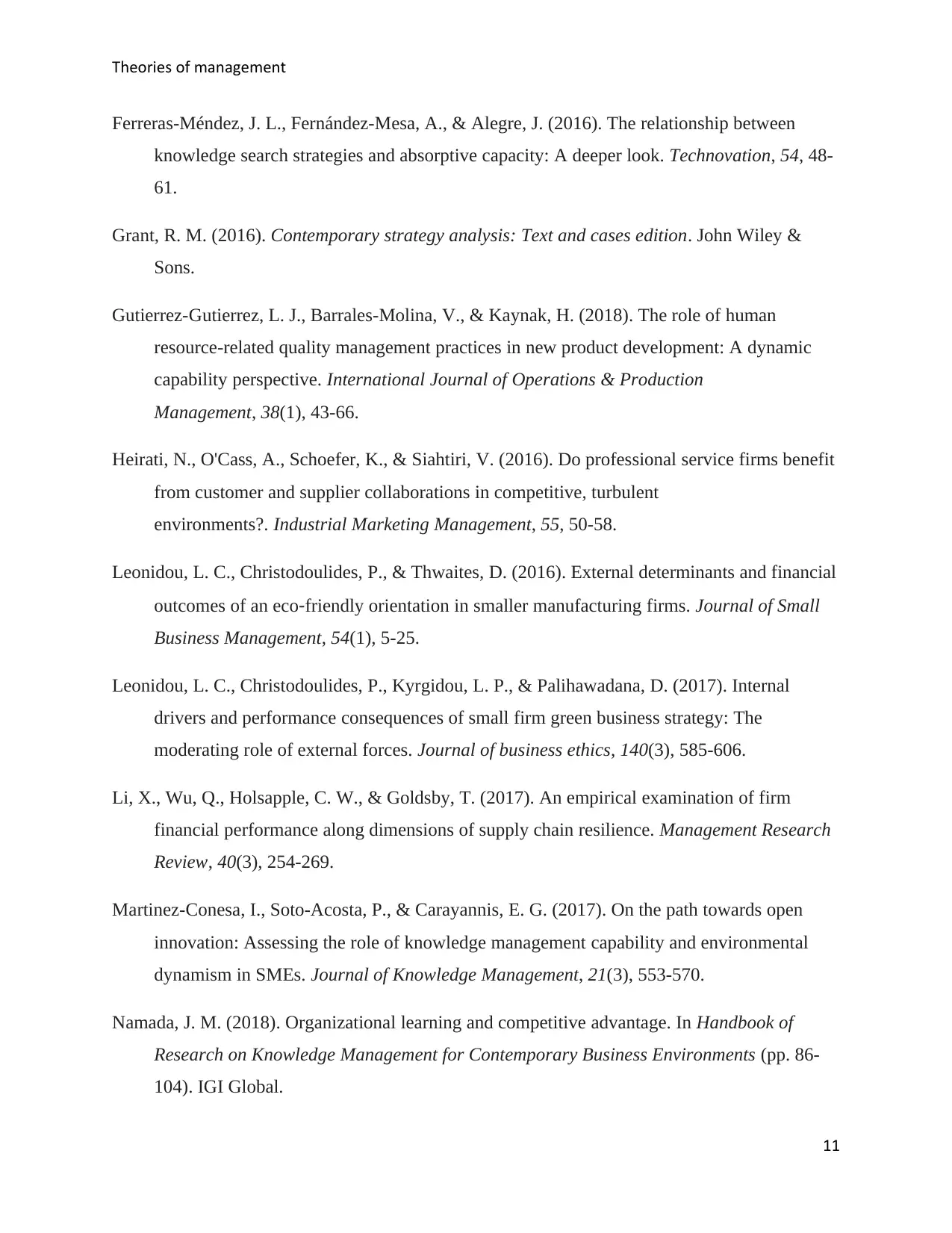
Theories of management
Ferreras-Méndez, J. L., Fernández-Mesa, A., & Alegre, J. (2016). The relationship between
knowledge search strategies and absorptive capacity: A deeper look. Technovation, 54, 48-
61.
Grant, R. M. (2016). Contemporary strategy analysis: Text and cases edition. John Wiley &
Sons.
Gutierrez-Gutierrez, L. J., Barrales-Molina, V., & Kaynak, H. (2018). The role of human
resource-related quality management practices in new product development: A dynamic
capability perspective. International Journal of Operations & Production
Management, 38(1), 43-66.
Heirati, N., O'Cass, A., Schoefer, K., & Siahtiri, V. (2016). Do professional service firms benefit
from customer and supplier collaborations in competitive, turbulent
environments?. Industrial Marketing Management, 55, 50-58.
Leonidou, L. C., Christodoulides, P., & Thwaites, D. (2016). External determinants and financial
outcomes of an eco‐friendly orientation in smaller manufacturing firms. Journal of Small
Business Management, 54(1), 5-25.
Leonidou, L. C., Christodoulides, P., Kyrgidou, L. P., & Palihawadana, D. (2017). Internal
drivers and performance consequences of small firm green business strategy: The
moderating role of external forces. Journal of business ethics, 140(3), 585-606.
Li, X., Wu, Q., Holsapple, C. W., & Goldsby, T. (2017). An empirical examination of firm
financial performance along dimensions of supply chain resilience. Management Research
Review, 40(3), 254-269.
Martinez-Conesa, I., Soto-Acosta, P., & Carayannis, E. G. (2017). On the path towards open
innovation: Assessing the role of knowledge management capability and environmental
dynamism in SMEs. Journal of Knowledge Management, 21(3), 553-570.
Namada, J. M. (2018). Organizational learning and competitive advantage. In Handbook of
Research on Knowledge Management for Contemporary Business Environments (pp. 86-
104). IGI Global.
11
Ferreras-Méndez, J. L., Fernández-Mesa, A., & Alegre, J. (2016). The relationship between
knowledge search strategies and absorptive capacity: A deeper look. Technovation, 54, 48-
61.
Grant, R. M. (2016). Contemporary strategy analysis: Text and cases edition. John Wiley &
Sons.
Gutierrez-Gutierrez, L. J., Barrales-Molina, V., & Kaynak, H. (2018). The role of human
resource-related quality management practices in new product development: A dynamic
capability perspective. International Journal of Operations & Production
Management, 38(1), 43-66.
Heirati, N., O'Cass, A., Schoefer, K., & Siahtiri, V. (2016). Do professional service firms benefit
from customer and supplier collaborations in competitive, turbulent
environments?. Industrial Marketing Management, 55, 50-58.
Leonidou, L. C., Christodoulides, P., & Thwaites, D. (2016). External determinants and financial
outcomes of an eco‐friendly orientation in smaller manufacturing firms. Journal of Small
Business Management, 54(1), 5-25.
Leonidou, L. C., Christodoulides, P., Kyrgidou, L. P., & Palihawadana, D. (2017). Internal
drivers and performance consequences of small firm green business strategy: The
moderating role of external forces. Journal of business ethics, 140(3), 585-606.
Li, X., Wu, Q., Holsapple, C. W., & Goldsby, T. (2017). An empirical examination of firm
financial performance along dimensions of supply chain resilience. Management Research
Review, 40(3), 254-269.
Martinez-Conesa, I., Soto-Acosta, P., & Carayannis, E. G. (2017). On the path towards open
innovation: Assessing the role of knowledge management capability and environmental
dynamism in SMEs. Journal of Knowledge Management, 21(3), 553-570.
Namada, J. M. (2018). Organizational learning and competitive advantage. In Handbook of
Research on Knowledge Management for Contemporary Business Environments (pp. 86-
104). IGI Global.
11
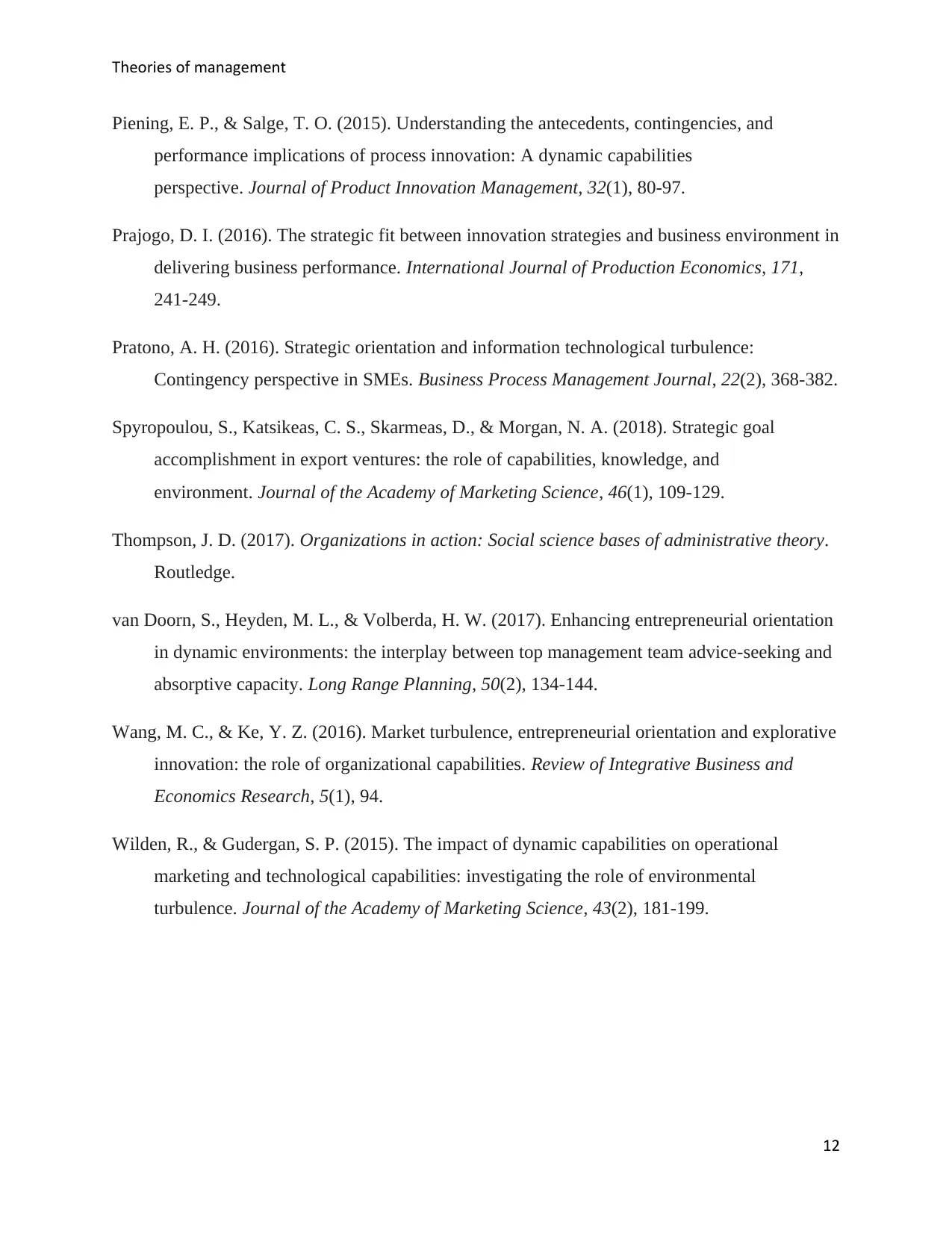
Theories of management
Piening, E. P., & Salge, T. O. (2015). Understanding the antecedents, contingencies, and
performance implications of process innovation: A dynamic capabilities
perspective. Journal of Product Innovation Management, 32(1), 80-97.
Prajogo, D. I. (2016). The strategic fit between innovation strategies and business environment in
delivering business performance. International Journal of Production Economics, 171,
241-249.
Pratono, A. H. (2016). Strategic orientation and information technological turbulence:
Contingency perspective in SMEs. Business Process Management Journal, 22(2), 368-382.
Spyropoulou, S., Katsikeas, C. S., Skarmeas, D., & Morgan, N. A. (2018). Strategic goal
accomplishment in export ventures: the role of capabilities, knowledge, and
environment. Journal of the Academy of Marketing Science, 46(1), 109-129.
Thompson, J. D. (2017). Organizations in action: Social science bases of administrative theory.
Routledge.
van Doorn, S., Heyden, M. L., & Volberda, H. W. (2017). Enhancing entrepreneurial orientation
in dynamic environments: the interplay between top management team advice-seeking and
absorptive capacity. Long Range Planning, 50(2), 134-144.
Wang, M. C., & Ke, Y. Z. (2016). Market turbulence, entrepreneurial orientation and explorative
innovation: the role of organizational capabilities. Review of Integrative Business and
Economics Research, 5(1), 94.
Wilden, R., & Gudergan, S. P. (2015). The impact of dynamic capabilities on operational
marketing and technological capabilities: investigating the role of environmental
turbulence. Journal of the Academy of Marketing Science, 43(2), 181-199.
12
Piening, E. P., & Salge, T. O. (2015). Understanding the antecedents, contingencies, and
performance implications of process innovation: A dynamic capabilities
perspective. Journal of Product Innovation Management, 32(1), 80-97.
Prajogo, D. I. (2016). The strategic fit between innovation strategies and business environment in
delivering business performance. International Journal of Production Economics, 171,
241-249.
Pratono, A. H. (2016). Strategic orientation and information technological turbulence:
Contingency perspective in SMEs. Business Process Management Journal, 22(2), 368-382.
Spyropoulou, S., Katsikeas, C. S., Skarmeas, D., & Morgan, N. A. (2018). Strategic goal
accomplishment in export ventures: the role of capabilities, knowledge, and
environment. Journal of the Academy of Marketing Science, 46(1), 109-129.
Thompson, J. D. (2017). Organizations in action: Social science bases of administrative theory.
Routledge.
van Doorn, S., Heyden, M. L., & Volberda, H. W. (2017). Enhancing entrepreneurial orientation
in dynamic environments: the interplay between top management team advice-seeking and
absorptive capacity. Long Range Planning, 50(2), 134-144.
Wang, M. C., & Ke, Y. Z. (2016). Market turbulence, entrepreneurial orientation and explorative
innovation: the role of organizational capabilities. Review of Integrative Business and
Economics Research, 5(1), 94.
Wilden, R., & Gudergan, S. P. (2015). The impact of dynamic capabilities on operational
marketing and technological capabilities: investigating the role of environmental
turbulence. Journal of the Academy of Marketing Science, 43(2), 181-199.
12
⊘ This is a preview!⊘
Do you want full access?
Subscribe today to unlock all pages.

Trusted by 1+ million students worldwide
1 out of 12
Related Documents
Your All-in-One AI-Powered Toolkit for Academic Success.
+13062052269
info@desklib.com
Available 24*7 on WhatsApp / Email
![[object Object]](/_next/static/media/star-bottom.7253800d.svg)
Unlock your academic potential
Copyright © 2020–2025 A2Z Services. All Rights Reserved. Developed and managed by ZUCOL.




